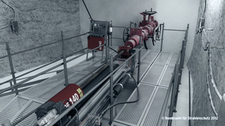First chamber of Asse mine being drilled into
Important step toward safe decommissioning
Date 2012.06.01
Progress in the remediation of the Asse mine: When the visit of Federal Environment Minister, Peter Altmaier, to the repository near Wolfenbüttel was about to come to an end, drilling works started at the first chamber containing radioactive waste.
Asse remediation is a unique task
"Today’s drilling into the first Asse chamber is an important step toward the long-term safe decommissioning. The remediation of Asse is a unique task for which there is no experience available. This difficult task can only be solved if all parties involved are co-operating and are aware of their joint responsibility,"
the president of the Federal Office for Radiation Protection (BfS), Wolfram König, emphasised during the visit.
The president of the BfS emphasised that a start of retrieval as late as in the year 2036 was not acceptable This point in time had been stated in an overall schedule commissioned by the BfS. The overall schedule has been based on the previous experiences gained in the procedures and on the currently effective boundary conditions the BfS needs to apply in terms of Asse. Together with the Federal Environment Ministry, all options to accelerate things are to be identified in order to save time, the latter being required because of the state of the repository.
Practical phase of fact-finding starts

![]() In a video the BfS shows how emplacement chamber 7 is to be drilled into through the ca. 20-m-thick sealing structure (video in German only).
In a video the BfS shows how emplacement chamber 7 is to be drilled into through the ca. 20-m-thick sealing structure (video in German only).
The practical phase of the so-called fact-finding starts with drilling into chamber 7 in a depth of 750 m. One result of the comparison of different decommissioning options was that still existing uncertainties relating to the retrieval of the waste needed to be clarified initially. This is being done by an in-depth inquiry of facts by drilling into two emplacement chambers, opening them and test-wise recovering part of the waste. This is done to systematically answer open questions key to retrieval such as the radiation exposure to the operating staff.
The Federal Office for Radiation Protection has been operating the Asse mine since January 2009 and for the first time according to the strict provisions of nuclear law. It had compared several different decommissioning options in terms of their feasibility and the long-term safety for man and environment. On 15 January 2010, the BMU and the BfS announced that retrieving the waste was the best option, as according to the present state of knowledge, it was the only one through which the long-term safety of man and environment could be proven. König: "Retrieval is still the best option. We need to ascertain though that it is technically feasible to recover the drums and that the safety of the staff and the people in the area is not at risk."

